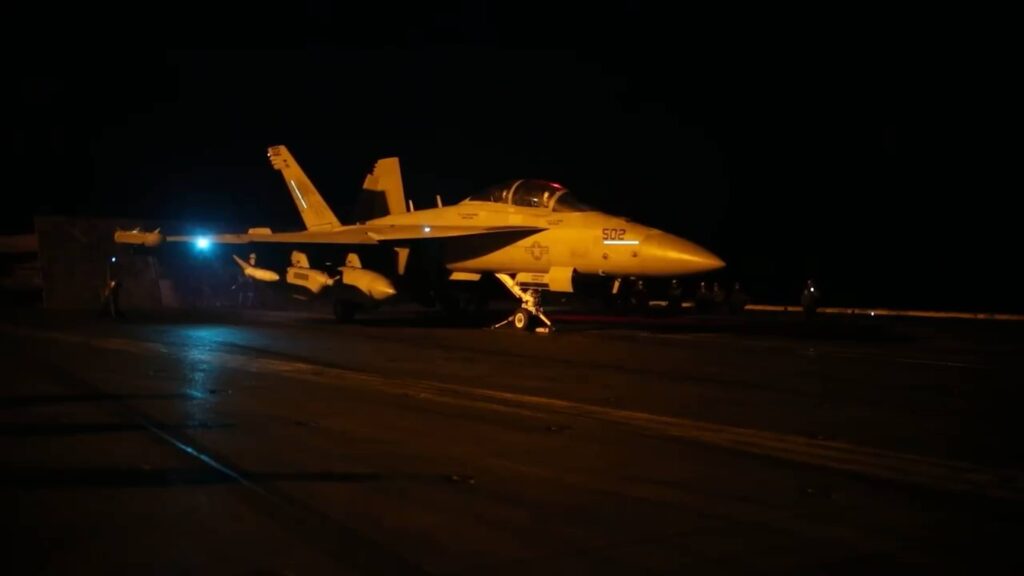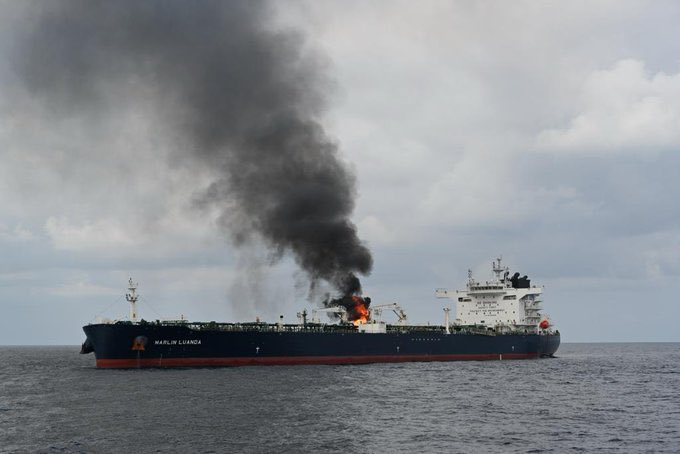Self-deterrence is a defense concept that a state may be restrained from using its military power not by the fear of a counter strike but rather owing to reputational concerns arising from moral, legal or other considerations. This concept may partly explain US reluctance to escalate the current level of military conflict with Iran, though there are other tools at the US disposal as well.
Houthi Resilience in Yemen and the Red Sea
After nearly three months of Houthi attacks on merchant shipping, during which time the US merely defended against Houthi drone and missile attacks on its warships, the United States finally began to strike back at Houthi facilities. On January 11, American and British fighters, using surface ships and submarines and with support from Australia, Canada, Bahrain, and the Netherlands, launched air strikes on 60 targets in 28 Yemeni locations. These included bases near the capital Sanaa and the city of Taiz, as well as the naval base at the Red Sea port of Hodeidah. The strikes successfully hit radar systems, and storage and launch sites for drones, cruise and ballistic missiles.
Announcing the strikes, President Joe Biden bravely asserted that “these targeted strikes are a clear message that the United States and our partners will not tolerate attacks on our personnel or allow hostile actors to imperil freedom of navigation in one of the world’s most critical commercial routes.” The Houthis were not deterred, however, and vowed to continue striking ships in the Red Sea and more recently in the Gulf of Aden as well.
The Houthis were as good as their word. They again struck merchant shipping with what the Defense Department asserted were “anti-ship ballistic missiles, land-attack cruise missiles, uncrewed surface vessels and unmanned surface vehicles.” After more Houthi attacks, including against an American merchant vessel, on January 22, the US launched more strikes on Houthi targets. The second major strike was once again launched in conjunction with British forces and support from the other four states. According to a Defense Department release, the operation hit “eight Houthi targets, including an underground storage site and locations associated with the rebel group’s missile and air surveillance capabilities.”
Although Pentagon spokesmen insisted after each of the major strikes that they had seriously degraded Houthi capabilities, officials admitted that “that does not mean they have no more capability.” Indeed, the Houthis continued to target both merchant shipping and military warships. In the early morning hours of January 24 (Yemen time) the US launched a third strike, this time against two Houthi anti-ship missiles that were aimed into the southern Red Sea and were prepared to launch, according to the U.S. Central Command.

The Houthis seem to be able to regroup and attack Red Sea shipping even after their facilities appear to have been seriously degraded, using numerous mobile launchers that “shoot and scoot” back into hiding. It is therefore extremely difficult for the United States and its partners to silence the Houthi drones, missiles and rockets. As a result, major shipping lines have begun to reroute their ships past the southern tip of Africa.
The Houthis benefit from the fact that American attacks are of necessity intermittent. There are not enough U.S. drones to maintain constant surveillance over Houthi territory in order to attack launchers as soon as they emerge from hiding. Nor is the single American aircraft carrier that is deployed in the Red Sea capable of maintaining twenty-four-hour operations. While the British have stated that they are ready to deploy one of their Queen Elizabeth class carriers to operate alongside the American Dwight D. Eisenhower carrier task force to enable round the clock operations, the British carrier has yet to arrive in the region.
An additional and significant reason for Houthi resilience is the support that the terrorists continue to receive from Iran. Tehran has transferred drone jammers and parts for long-range rockets and missiles to the Houthis. The Iranians and the Lebanese Hezbollah have also dispatched engineers to help the Houthis assemble their drones and advisors to help them plan and launch their attacks on shipping. Because Tehran ships its weapons primarily by sea, it is extremely difficult to prevent them from reaching the Houthis. Moreover, Iran not only transports equipment to Yemen on dhows, skiffs and larger ships, but also uses “floating packages” rather than ship-to-ship transfers that are difficult to identify from aerial surveillance.
The Biden administration has responded to Iranian support of Houthi attacks by requesting Swiss officials to reach out to Iran to desist, and pleading with Beijing to intervene with Tehran as well. This enfeebled response to Iran’s ongoing support of Houthi military operations is hardly likely to result in a change of Iranian behavior.

Opportunities to Pressure Iran Elsewhere
The recent spate of cross border attacks between Iran and Pakistan offers the Administration an opportune moment to pressure Tehran. Iran attacked a terrorist base in Pakistan after several of its police and soldiers were killed over the past several months. Among those dead in the Iranian strike, however, were two children. Additionally, the Iranian attack damaged a mosque and injured several people. Two days later the outraged Pakistanis launched a reprisal attack on the Baluch Liberation Army, which has operated for decades from Iranian territory. The Pakistan attack on the terrorist targets in Iran, which its military termed “Operation Death to Insurgents” employed “killer drones, rockets, loitering munitions and standoff weapons” and resulted in the deaths of nine people.
Recognizing that it could find itself in a longer-term conflict with nuclear-armed Pakistan, Tehran elected to send reassuring messages to Islamabad. Additional Baluch Liberation Army strikes against Pakistani targets could further inflame tensions, which have not really died down.
Iran must be concerned that it could find itself simultaneously at odds on three fronts: Pakistan, an American-led “coalition of the willing” in the Red Sea and Gulf of Aden, and in Iraq where American forces are striking back in retaliation for attacks by Iranian-supported militias.
The Biden administration would be wise to exploit that concern. Until now it appears that the administration fears that any direct confrontation with Iran would lead to a regional conflict that the US desperately seeks to avoid, especially in an election year. Yet self-deterrence is hardly a winning policy and in any event, Iran does not have anything like the ability to initiate a conflict with the United States, which the Mullahs recognize could result in chaos leading to their overthrow.
Further pressure on Iran will not necessarily lead to a regional conflict. For example, Donald Trump’s maximum pressure policy on Iran, which targeted some 80 percent of the nation’s economy, seriously weakened that economy but did not lead to anything like a major Iranian response. Even the assassination of Quds Force leader Qasem Soleimani one year before Trump left office has yet to provoke major Iranian reprisals.
If the administration wishes to prevent Iran from supporting the Houthis, and for that matter, the Iraqi militias, it should seize this moment to exert real pressure on Iran and its economy.
Such pressure could take the form of conducting or condoning cyber strikes on the country’s oil facilities, notably the Kharg Island oil terminal, or terminating the waivers and other concessions to Iran that have enabled Tehran to amass billions in oil revenues. Such a policy would render it far more difficult for Iran to maintain its current level of support for “the axis of resistance” that it leads. And doing so would be far more effective than turning to the Swiss and, of all people, the Chinese to beseech the Mullahs to moderate their aggressive behavior throughout the Middle East.



